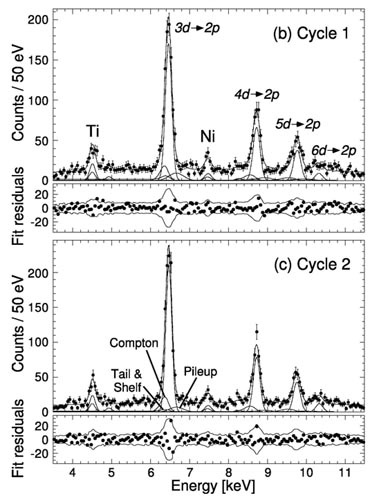SMI ( Stefan-Meyer-Institut für subatomare Physik der Österreichischen Akademie der Wissenschaften) and other international collaborations settled the more-than 30 years' long discrepancy between theories and experiments on the strong-interaction shift of the kaonic helium-4 2p state by an X-ray spectroscopy experiment at KEK in Japan. The experimental results are reported in Physics Letters B 1 on 13. Aug. 2007.
The collaborators of the E570 experiment measured X-ray energy of kaonic helium atoms, which are an atom consisting of a kaon (a negatively charged heavy particle) and a helium nucleus. The kaonic helium X-rays were detected by large-area Silicon Drift Detectors (SDDs), which readout system was developed by SMI.
The studies of the low-energy K-N strong interaction with strangeness have been performed by measurements of the kaonic atom X-rays with atomic number Z=1-92. It is known that the shifts and widths due to the strong interaction can be systematically understood using phenomenological optical potential models.
However, there is a large discrepancy between the theories and experiments on the kaonic helium 2p state. A large repulsive shift (about -40 eV) was measured by three experimental groups in the 1970's and 80's, while a very small shift (< 1 eV) was obtained by the optical models calculated from the kaonic atom X-ray data with Z>2. This significant disagreement (a difference of over 5 standard deviations) between the experimental results and the theoretical calculations is known as the "kaonic helium puzzle".
A possible large shift was predicted using the model assuming the existence of the deeply bound kaonic nuclear states. However, even using this model, the large shift of 40 eV measured in the experiments cannot be explained. A re-measurement of the shift of the kaonic helium X-rays is one of the top priority in the research activities.
The new measurement of the kaonic helium X-ray was performed using the KEK-PS K5 kaon beam channel in 2005. As a target, super fluid liquid helium was used. The kaonic-atom production points were detected by measuring the charged particles produced by the kaon-nucleus reaction using the vertex chambers, and in addition, the stopped-kaon events in the helium target were selected using a counter measuring the kaon velocity. The X-rays from the kaonic atoms and the Ti/Ni calibration foils were detected using 8 SDDs, which have excellent resolution in energy [~190 eV (FWHM) at 6.5 keV] and timing [~160 ns (rms)]. In total, about 2000 events of the kaonic helium La X-rays are collected.
The fit functions of the X-ray peaks were carefully studied. The function to fit the pileup events were obtained using the flash ADC data, in which the signal shape of the SDDs were recorded. The functions to fit the low-energy tails were deduced from the fit of the Ti/Ni peaks. The effects of the incoherent ( Compton ) scattering caused in helium were estimated by the GEANT4 simulations. In addition, the possible energy shifts caused by the pion-induced fluorescence X-rays were checked in the measurement of the pion beams at PSI in Switzerland. The systematic error of the fit functions is found to be 2 eV.
The energy spectra of the kaonic helium X-rays are shown in the figure, and the measured energy of the kaonic helium X-ray lines are given in the table. The comparison of the previous experimental results is also shown. 3 times higher statistics of the kaonic events, twice better energy resolution, and 6 times higher signal-to-background ratio were obtained. The obtained shift on the kaonic helium 2p state is 2 ± 2(stat) ± 2(sys) eV. This shift is consistent with the theoretically calculated values by both the optical potential models (~ 0 eV) and the model predicting the deeply bound kaonic states (< ± 10 eV), while it disagrees with the values in the past experiments. Therefore, we conclude that the long-standing problem in the energy level of the kaonic helium-4 2p state was solved. To understand further information on the low-energy KN interaction, new experiments to determine the shift and width of kaonic helium-3 and of kaonic hydrogen/deuterium are now in preparation in J-Parc and in LNF, respectively.
1 S. Okada et al ., Precision measurement of the 3 d ® 2 p x-ray energy in kaonic 4 He,, Physics Letters B, Volume 653, Issues 5-6 , 27 September 2007, Pages 387-391.


